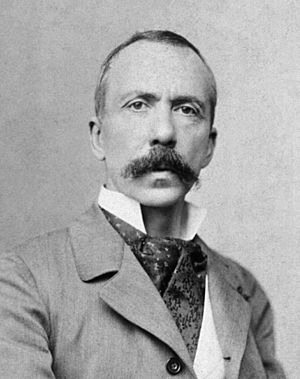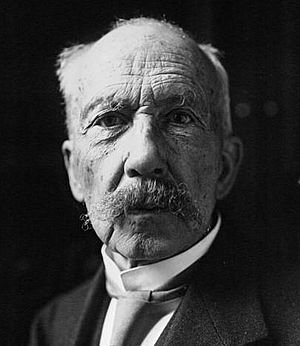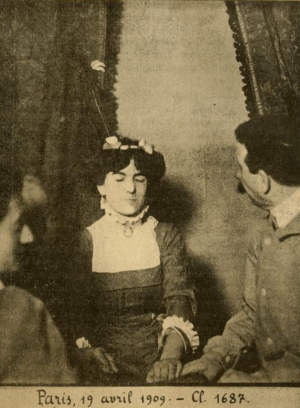Charles Richet facts for kids
Quick facts for kids
Charles Richet
|
|
|---|---|
 |
|
| Born | 25 August 1850 Paris, France
|
| Died | 4 December 1935 (aged 85) Paris, France
|
| Alma mater | University of Paris |
| Awards | Nobel Prize in Physiology or Medicine (1913) |
Charles Robert Richet (born August 25, 1850 – died December 4, 1935) was a French scientist. He was a physiologist, which means he studied how living things work. He taught at the Collège de France and was a pioneer in immunology, the study of how the body fights off diseases.
In 1913, Richet won the Nobel Prize in Physiology or Medicine. He received this award for his important work on something called anaphylaxis. This is a severe, sometimes dangerous, allergic reaction.
Richet also spent many years studying paranormal and spiritualist ideas. He even created the word "ectoplasm" for a substance he believed was involved in these phenomena. However, it's important to know that Richet also held beliefs about black people and eugenics that are now widely seen as wrong and harmful. Eugenics is a controversial idea that aimed to "improve" humanity through controlled breeding.
His family continued his work in medical science. His son Charles and grandson Gabriel also became professors. Gabriel Richet was a pioneer in nephrology, which is the study of kidneys.
Contents
About Charles Richet's Life and Work
Charles Richet was born in Paris, France, on August 25, 1850. His father was Alfred Richet. Charles went to school at the Lycee Bonaparte in Paris. Later, he studied medicine at the University of Paris.
He worked as an intern at the Salpêtrière hospital in Paris. There, he watched Jean-Martin Charcot work with patients who were then called "hysterical."
In 1887, Richet became a professor of physiology at the Collège de France. He studied many different topics. These included how the brain works, how we digest food, and how warm-blooded animals keep their body temperature stable. He also studied breathing.
Richet became a member of important scientific groups. In 1898, he joined the Académie de Médecine. In 1914, he became a member of the Académie des Sciences.
He also discovered a pain-relieving drug called chloralose with Maurice Hanriot.
Richet had many interests outside of science. He wrote books about history, how societies work, philosophy, and psychology. He also wrote plays and poetry. He was even one of the first people to work in aviation (flying).
He was also involved in the French movement for peace. Starting in 1902, groups that wanted peace began to meet. Richet helped lead a small permanent group called the Delegation of French Pacifist Societies.
Discovery of Anaphylaxis
Richet, working with Paul Portier, made a very important discovery. They found out about a strong allergic reaction called anaphylaxis. In 1901, they went on a science trip with Albert I, Prince of Monaco. They were on Albert's ship, Princesse Alice II, near the French Atlantic coast.
On this trip, they took out a toxin, or poison, from sea creatures like the Portuguese man o' war and sea anemones. They called this toxin a hypnotoxin.
In their first experiment on the ship, they gave the toxin to a dog. They thought the dog would become immune to it, meaning its body would learn to fight it off. Instead, the dog had a very strong and bad reaction.
In 1902, they did the experiments again in their lab. They found that dogs usually handled the first dose of the toxin well. But if they gave the dogs more injections three weeks later, the dogs always went into a fatal shock. This happened no matter how much toxin they were given.
So, they learned that the first dose, instead of protecting the dogs, made later doses deadly.
In 1902, Richet first called this reaction aphylaxis. He later changed it to anaphylaxis because he thought it sounded better. The word comes from Greek. "Ana-" means "against," and "phylaxis" means "protection."
On February 15, 1902, Richet and Portier shared their findings with a science group in Paris. Their research was the start of the scientific study of allergy. An allergy is when your body reacts badly to something harmless, like pollen or certain foods.
Their work helped explain things like hay fever and other allergic reactions. It also helped understand asthma and some cases of sudden heart problems. Richet kept studying anaphylaxis. In 1913, he won the Nobel Prize in Physiology or Medicine for this important work.
Interest in Parapsychology
Richet was very interested in extrasensory perception (ESP) and hypnosis. ESP is the idea of knowing things without using your normal senses. In 1884, he became interested in a medium named Eusapia Palladino. A medium is someone who claims to talk to spirits.
In 1891, Richet started a science journal called Annales des sciences psychiques. He talked with famous people who studied occult and spiritualist topics. These included Albert von Schrenck-Notzing and Frederic William Henry Myers.
In 1919, Richet became the honorary chairman of a group in Paris called the Institut Métapsychique International. In 1930, he became its full-time president.
Richet hoped to find a scientific way to prove that paranormal things were real. He wrote that a "sixth sense" might exist. This sense would allow people to know things through special "vibrations" that our normal senses can't pick up. In 1905, Richet became president of the Society for Psychical Research in the United Kingdom.
In 1894, Richet created the word ectoplasm. He thought that some mediumship could be explained by a material substance coming out of the medium's body. But he didn't believe this substance had anything to do with spirits. He thought the idea of spirits was not scientific. Instead, he supported the "sixth sense" idea.
Richet believed in extrasensory perception. However, he did not believe in life after death or spirits. He wrote about his "sixth sense" idea in his 1928 book Our Sixth Sense.
He studied many mediums, including Eva Carrière and Leonora Piper. From 1905 to 1910, Richet went to many séances with the medium Linda Gazzera. He claimed she was a real medium who could move objects with her mind, which is called psychokinesis. However, Gazzera was later found to be a fraud in 1911.
Richet was also fooled by Joaquin María Argamasilla, who was called the "Spaniard with X-ray Eyes." Argamasilla claimed to have real psychic powers, but Harry Houdini showed he was a fraud in 1924. Some historians say Richet was also tricked by other fraudulent mediums.
The historian Ruth Brandon said that Richet was too quick to believe in psychical research. She noted his "will to believe" and his unwillingness to accept evidence that went against his beliefs.
Views on Eugenics and Race
Richet supported eugenics. This was a belief that humanity could be improved by controlling who has children. He thought that people with mental disabilities should not be allowed to marry. He wrote about his eugenics ideas in his 1919 book La Sélection Humaine. From 1920 to 1926, he was the president of the French Eugenics Society.
It is important to know that Richet also held beliefs about black people that are now widely seen as wrong and harmful. He compared them to apes and said they were not as smart as others. These views are considered racist and are not supported by science today.
Works by Charles Richet
Richet's books about parapsychology were a big part of his later life. These include Traité de Métapsychique (Treatise on Metapsychics, 1922) and Our Sixth Sense (1928).
- Maxwell, J & Richet, C. Metapsychical Phenomena: Methods and Observations (London: Duckworth, 1905).
- Richet, C. Physiologie Travaux du Laboratoire (Paris: Felix Alcan, 1909)
- Richet, C. La Sélection Humaine (Paris: Felix Alcan, 1919)
- Richet, C. Traité De Métapsychique (Paris: Felix Alcan, 1922).
- Richet, C. Thirty Years of Psychical Research (New York: The Macmillan Company, 1923).
- Richet, C. Our Sixth Sense (London: Rider, 1928).
See also
 In Spanish: Charles Robert Richet para niños
In Spanish: Charles Robert Richet para niños
- Breguet-Richet Gyroplane
- Eusapia Palladino



